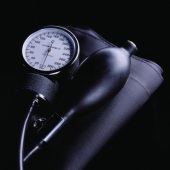
MONDAY, June 16, 2014 (HealthDay News) — Lower is not necessarily better when it comes to treating high blood pressure, researchers report.
It appears that reducing systolic blood pressure below 120 mm Hg (millimeters of mercury) provides no additional benefits for people with high blood pressure, according to new findings from a two-decades-long study of heart disease risk.
This could mean fewer medications for people who have gotten their high blood pressure within the “normal” range of 120 to 139, said lead author Dr. Carlos Rodriguez, associate professor of public health sciences at Wake Forest Baptist Medical Center in Winston-Salem, N.C.
“We were a little surprised by the findings,” Rodriguez said. “I was expecting that there would be sort of a linear relationship between blood pressure and cardiovascular health outcomes. But the relationship leveled off once systolic blood pressure dropped below 140 millimeters of mercury.”
Uncontrolled high blood pressure increases your risk of heart failure, stroke and heart attack. About one in three Americans has high blood pressure, and only half of those have their condition under control, according to the Centers for Disease Control and Prevention.
Systolic pressure is the top number in a standard blood pressure reading — for example, 120/80 — and represents the pressure in the arteries when the heart muscle contracts. The bottom number, diastolic pressure, represents pressure in the arteries between heartbeats.
Up till now, many heart doctors have tackled high blood pressure by trying to get a patient’s blood pressure as low as possible through drugs and lifestyle modifications such as diet and exercise, said Dr. Andrew Freeman, assistant professor of cardiology at National Jewish Health in Denver.
“During my training, we were taught that lower is better,” said Freeman, who was not involved in the study. “It’s turning out that sometimes less is more, in terms of medications to control blood pressure.”
Previous studies have shown a progressive increase in heart disease risk as systolic blood pressure rose above 115, the researchers said. But it was not known whether systolic pressure below 120 in patients with high blood pressure lowered their risk of stroke or heart attack.
To test this, researchers followed 4,480 people for about 22 years, tracking their blood pressure and monitoring their heart health. Participants were an average age of 55 at the start of the study, and more than two of every five had high blood pressure.
The results confirmed that people with high blood pressure have a greater risk of heart attack or stroke, and that the risk increases as blood pressure rises.
For example, people with systolic pressure between 140 to 159 had a 16 percent greater risk of a heart problem, while people with systolic pressure 160 or higher had a 73 percent increased risk of heart attack or stroke, the researchers reported.
“Clearly, exceeding 140 was not good. If you exceeded 160, it was worse,” said Donna Arnett, immediate past president of the American Heart Association and chair of epidemiology at the University of Alabama at Birmingham School of Public Health.
But the researchers also found that once systolic pressure drops lower than the 120 to 139 category, driving that number even lower did not improve patients’ heart health.
It appears that the optimal blood pressure range for people with high blood pressure is 120 to 139 systolic, Rodriguez said.
“When the blood pressure goes below 140, there’s definite cardiovascular health benefits. We saw a significant reduction in events,” he said. “These findings suggest that you don’t need to go lower than that to receive those benefits.”
A large-scale clinical trial sponsored by the National Institutes of Health is currently under way that will test these new findings, published online June 16 in JAMA Internal Medicine.
If these findings are verified, they could lead to a change in the way doctors prescribe blood pressure medication, Freeman said.
“We may be less aggressive in terms of how fast or how much we push the pedal to the metal, so to speak,” he said. If a new patient shows good results with one medication, doctors may be less inclined to add another.
However, patients should not necessarily assume that reaching the optimal range means they can take fewer meds, Arnett said.
“There may be many other competing risk factors such as diabetes or high cholesterol that a doctor would want to take into account before making a decision like that,” she said.
More information
For more on blood pressure, visit the American Heart Association.
Copyright © 2025 HealthDay. All rights reserved.

